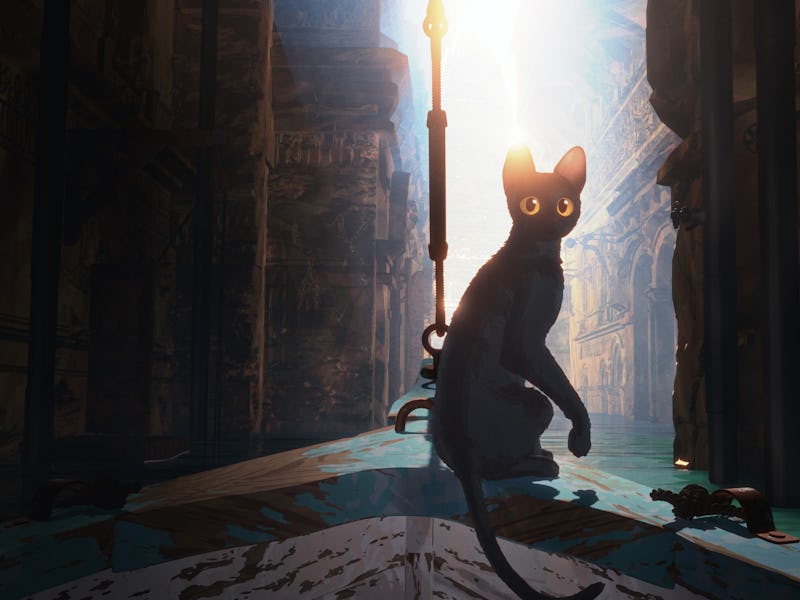An Adventure Story For A Post-Human World
Flow might be the timeliest movie of the past year.

In a time where many humans seem pretty fed up with each other, the Latvian film Flow is an adventure story that removes us from the equation entirely. A story deeply suited for our times? There’s no question of that, but just how suited is it? Only time itself will provide the answer to that question. Or more accurately, we will.
The animated setting of Flow is a study in beautiful bleakness, with gorgeous visuals of forests and a natural world that’s now left to itself. Mostly anyway, since animals (just as lovingly animated as their surroundings) are still struggling to survive in the aftermath of humanity’s worst decisions. And we have a black cat with wide, Disney heroine-esque eyes to get us invested as it wanders the ruins of what is to all appearances a post-human world.
With no dialogue, we’re also free to observe a journey that’s as much about how to build a life as it is to survive, along with plenty of spiritual contemplation. Contemplative thinking, in fact, seems to be the reason for the movie’s existence; the film practically seems to be throwing its arms open to all, even making use of the free and open-source software Blender for its animation.
Sincerity and nostalgia tend to be a rather irresistible combination, and since those open-source values mean Flow’s look is reminiscent of an early aughts video game rather than slick, photorealistic CGI, chances are that its appeal to audiences and critics alike (see Rotten Tomatoes for confirmation) is partly a longing for simplicity in a world more and more dominated by unnatural AI perfection and algorithms. It’s Homeward Bound sans the safety and warmth of an awaiting human home.
In Flow, the warmth springs from the found family which slowly comes into existence. Beginning the film as a committed loner in typical cat fashion, the film’s nameless feline protagonist is forced into companionship as waters rise and quickly flood the deserted human abode it calls home. The place is littered with cat art and cat statues of various sizes, confirming a very cat-like view of themselves as the center of their chosen, luxurious universe.
But when nature literally comes to the cat’s doorstep, it’s forced to reckon with its place in this new world, if indeed there is one. Luckily, there are remnants of humanity's better decisions, including a boat the cat is eventually forced to share with a capybara, a lemur, a bird, and a dog as they attempt to stay afloat and find habitable dry land.
The found family of Flow.
Flow may ultimately be a movie with an uplifting message, but it’s not a cheapened one, as it gives its animal cast a dangerous world to navigate along with human characteristics such as ingenuity, greed, and most notable of all, empathy. This may be a movie about animal survival, but dog-eat-dog it isn’t. Cooperation rather than competition is what Flow endorses, and by the end, its core cast comes to embody the best of what we are capable of, while still remaining beasts.
Writer-director Gints Zilbalodis, who first broke out with the 2019 film Away, another dialogue-free film which took place in nature, clearly believes in the magical realism approach, keeping its mystical encounters close to earth even when an especially beautiful occurrence seems to contain an entire universe. He also does away with celebrity voices, choosing instead to record real animals for their sounds.
Once his animals truly become a family, their visceral journey together is what shines brightest as the danger around them ebbs and flows (pun mostly intended). It’s a voyage that sometimes feels downright hypnotic, but always enjoyable.